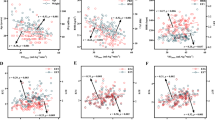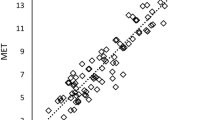Abstract
This study investigated the relationship between oxygen uptake (VO2), cardiac output (Q), stroke volume (SV), and heart rate (HR) in 54 men and 77 women (age = 69 ± 5 years) during incremental effort. Subjects performed a maximal cycle-ergometer test and VO2 was directly measured. HR and SV were assessed by ECG and cardiograph impedance. Regression equations were calculated for Q–VO2, HR–VO2, and Q–HR relationships. The equations obtained for women were (a) Q (l min−1) = 2.61 + 4.67 VO2 (l min−1)(r 2 = 0.84); (b) HR (bpm) = 62.03 + 46.55 VO2 (l min−1) (r 2 = 0.72); (c) \({\text{SV}\,{\text{(ml)}}}=100.6[1- {\text{e}}^{-2.6\; {\text{VO}_2}\;{(1\,{\text{min}}^{-1})}}]\) (r 2 = 0.41); (d) HR (bpm) = 41.48 + 9.24 Q (l min−1) (r 2 = 0.73). Equations for men were (a) Q (l min−1) = 2.52 + 5.70 VO2 (l min−1) (r 2 = 0.89); (b) HR (bpm) = 66.31 + 32.35 VO2 (l min−1) (r 2 = 0.72); (c) \({\text{SV}\,{\text{(ml)}}}=143.7[1- {\text{e}}^{-1.7\; {\text{VO}_2}\;{(1\,{\text{min}}^{-1})}}]\) (r 2 = 0.47); (d) HR (bpm) = 56.33 + 5.25 Q (l min−1) (r 2 = 0.69). The intercepts for Q–VO2 and HR–VO2 equations were similar for both genders, but the slopes were different (P < 0.05). The SV increased from baseline to 50–60% of VO2 peak in both groups. No gender effect was found in SV increasing pattern, but the absolute values were in general higher for men (P > 0.05). A significant difference between men and women was observed for both slopes and intercepts in the Q–HR relationship (P < 0.05). In conclusion, (a) Q–VO2 relation was linear during progressive effort; (b) regression intercepts were similar, but the slopes were higher for men compared to women; (c) SV–VO2 relationship was nonlinear and maximum SV was reached at very submaximal workload; (d) older men exhibited higher Q upward potential as well higher SV but lower HR for a given submaximal workload than women of similar age.




Similar content being viewed by others
References
ACSM (2006) ACSM’s guidelines for graded exercising testing and exercise prescription. Lippincott, Williams & Wilkins, Baltimore, MD
Astrand PO, Bergh U, Astrand PO, Bergh U, Kilbom A (1997) A 33-yr follow-up of peak oxygen uptake and related variables of former physical education students. J Appl Physiol 82(6):1844–1852
Becklake MR, Frank H, Dagenais GR, Ostiguy GL, Guzman CA (1965) Influence of age and sex on exercise cardiac output. J Appl Physiol 20(5):938–947
Bogaard HJ, Woltjer HH, Dekker BM, van Keimpema AR, Postmus PE, de Vries PM (1997a) Haemodynamic response to exercise in healthy young and elderly subjects. Eur J Appl Physiol Occup Physiol 75(5):435–442
Bogaard HJ, Woltjer HH, Postmus PE, de Vries PM (1997b) Assessment of the haemodynamic response to exercise by means of electrical impedance cardiography: method, validation and clinical applications. Physiol Meas 18(2):95–105
Bovens AM, van Baak MA, Vrencken JG, Wijnen JA, Saris WH, Verstappen FT (1993) Maximal aerobic power in cycle ergometry in middle-aged men and women, active in sports, in relation to age and physical activity. Int J Sports Med 14(2):66–71
Brischetto MJ, Millman RP, Peterson DD, Silage DA, Pack AI (1984) Effect of aging on ventilatory response to exercise and CO2. J Appl Physiol 56(5):1143–1150
Christou DD, Seals DR (2008) Decreased maximal heart rate with aging is related to reduced {beta}-adrenergic responsiveness but is largely explained by a reduction in intrinsic heart rate. J Appl Physiol 105(1):24–29 (Epub May 15)
Docherty JR (1990) Cardiovascular responses in ageing: a review. Pharmacol Rev 42(2):103–125
Faulkner JA, Heigenhauser GJ, Schork MA (1977) The cardiac output–oxygen uptake relationship of men during graded bicycle ergometry. Med Sci Sports 9(3):148–154
Fleg JL, Morrell CH, Bos AG, Brant LJ, Talbot LA, Wright JG, Lakatta EG (2005) Accelerated longitudinal decline of aerobic capacity in healthy older adults. Circulation 112(5):674–682
Fletcher GF, Balady GJ, Amsterdam EA, Chaitman B, Eckel R, Fleg J, Froelicher VF, Leon AS, Piña IL, Rodney R, Simons-Morton DA, Williams MA, Bazzarre T (2001) Exercise standards for testing and training: a statement for healthcare professionals from the American Heart Association. Circulation 104(14):1694–1740
Gates PE, Seals DR (2006) Decline in large elastic artery compliance with age: a therapeutic target for habitual exercise. Br J Sports Med 40(11):897–899
Gates PE, Tanaka H, Graves J, Seals DR (2003) Left ventricular structure and diastolic function with human ageing. Relation to habitual exercise and arterial stiffness. Eur Heart J 24(24):2213–2220
Geddes LA, Sadler C (1973) The specific resistance of blood at body temperature. Med Biol Eng 11(3):336–339
Gledhill N, Cox D, Jamnik R (1994) Endurance athletes’ stroke volume does not plateau: major advantage is diastolic function. Med Sci Sports Exerc 26(9):1116–1121
Granath A, Strandell T (1964) Relationships between cardiac output, stroke volume and intracardiac pressures at rest and during exercise in supine position and some anthropometric data in healthy old men. Acta Med Scand 176:447–466
Granath A, Jonsson B, Strandell T (1964) Circulation in healthy old men, studied by right heart catheterization at rest and during exercise in supine and sitting position. Acta Med Scand 176:425–446
Lakatta EG (1990) Changes in cardiovascular function with aging. Eur Heart J 11(Suppl C):22–29
Lakatta EG (1998) Aging and cardiovascular structure and function in healthy sedentary humans. Aging (Milano) 10(2):162–164
McElvaney GN, Blackie SP, Morrison NJ, Fairbarn MS, Wilcox PG, Pardy RL (1989) Cardiac output at rest and in exercise in elderly subjects. Med Sci Sports Exerc 21(3):293–298
McKelvie RS, Heigenhauser GJ, Jones NL (1987) Measurement of cardiac output by CO2 rebreathing in unsteady state exercise. Chest 92(5):777–782
Miles DS, Gotshall RW (1989) Impedance cardiography: noninvasive assessment of human central hemodynamics at rest and during exercise. Exerc Sport Sci Rev 17:231–263
Miyamoto Y, Niizeki K, Abe H (1992) Behavior of cardiac output during progressive exercise tests: a preliminary report. Ann Physiol Anthropol 11(3):225–230
Nottin S, Nguyen LD, Terbah M, Obert P (2004) Long-term endurance training does not prevent the age-related decrease in left ventricular relaxation properties. Acta Physiol Scand 181(2):209–215
Panton LB, Graves JE, Pollock ML, Garzarella L, Carroll JF, Leggett SH, Lowenthal DT, Guillen GJ (1996) Relative heart rate, heart rate reserve, and VO2 during submaximal exercise in the elderly. J Gerontol A Biol Sci Med Sci 51(4):M165–M171
Pearson AC, Gudipati CV, Labovitz AJ (1991) Effects of aging on left ventricular structure and function. Am Heart J 121(3 Pt 1):871–875
Pianosi PT (1997) Impedance cardiography accurately measures cardiac output during exercise in children with cystic fibrosis. Chest 111(2):333–337
Popović ZB, Prasad A, Garcia MJ, Arbab-Zadeh A, Borowski A, Dijk E, Greenberg NL, Levine BD, Thomas JD (2006) Relationship among diastolic intraventricular pressure gradients, relaxation, and preload: impact of age and fitness. Am J Physiol Heart Circ Physiol 290(4):H1454–H1459
Proctor DN, Beck KC, Shen PH, Eickhoff TJ, Halliwill JR, Joyner MJ (1998) Influence of age and gender on cardiac output-VO2 relationships during submaximal cycle ergometry. J Appl Physiol 84(2):599–605
Rodrigues MN, Vanfraechem JH, de Farinatti PT (2007) Non-invasive estimate of cardiac output during exercise based on impedance cardiography and oxygen uptake in the elderly. Arq Bras Cardiol 88(1):79–84
Seals DR, Hagberg JM, Spina RJ, Rogers MA, Schechtman KB, Ehsani AA (1994) Enhanced left ventricular performance in endurance trained older men. Circulation 89:198–205
Shibata S, Hastings JL, Prasad A, Fu Q, Okazaki K, Palmer MD, Zhang R, Levine BD (2008) ‘Dynamic’ Starling mechanism: effects of ageing and physical fitness on ventricular-arterial coupling. J Physiol 586(7):1951–1962
Stamford B (1988) Exercise and the elderly. In: Pandolf K (ed) Exercise and sport sciences reviews, vol 16. Macmillan Publications, New York, pp 341–379
Stringer WW, Hansen JE, Wasserman K (1997) Cardiac output estimated noninvasively from oxygen uptake during exercise. J Appl Physiol 82(3):908–912
Thomas SG, Paterson DH, Cunningham DA, McLellan DG, Kostuk WJ (1993) Cardiac output and left ventricular function in response to exercise in older men. Can J Physiol Pharmacol 71(2):136–144
Tochikubo O, Ishii M, Minamisawa K, Miyajima E, Kuji N, Saitoh J, Nakamura Y (1990) Fully automatic, noninvasive measurement of cardiac output by means of the CO2 rebreathing method and its clinical application to hypertensive patients. Jpn Heart J 31(4):461–476
Vella CA, Robergs RA (2005a) Non-linear relationships between central cardiovascular variables and VO2 during incremental cycling exercise in endurance-trained individuals. J Sports Med Phys Fitness 45(4):452–459
Vella CA, Robergs RA (2005b) A review of the stroke volume response to upright exercise in healthy subjects. Br J Sports Med 39(4):190–195
Weiss EP, Spina RJ, Holloszy JO, Ehsani AA (2006) Gender differences in the decline in aerobic capacity and its physiological determinants during the later decades of life. J Appl Physiol 101(3):938–944
Wiebe CG, Gledhill N, Warburton DE, Jamnik VK, Ferguson S (1998) Exercise cardiac function in endurance-trained males versus females. Clin J Sport Med 8(4):272–279
Zar JH (1984) Comparing simple linear regression equations. Biostatistical analysis. Prentice-Hall, Englewoods Cliff, NJ, p 718
Zwiren LD, Cureton KJ, Hutchinson P (1983) Comparison of circulatory responses to submaximal exercise in equally trained men and women. Int J Sports Med 4(4):255–259
Acknowledgments
This study was partially supported by a grant from the Brazilian Council for Research Development (CNPq, process 305729/2006-3) and Carlos Chagas Foundation for the Research Support in Rio de Janeiro (FAPERJ, process E26/102.916/2008). The authors thank Prof. Jacques Henri-Paul Vanfraechem from the Université Libre de Bruxelles for the valuable support during data assessment.
Author information
Authors and Affiliations
Corresponding author
Rights and permissions
About this article
Cite this article
Farinatti, P.T.V., Soares, P.P.S. Cardiac output and oxygen uptake relationship during physical effort in men and women over 60 years old. Eur J Appl Physiol 107, 625–631 (2009). https://doi.org/10.1007/s00421-009-1162-y
Accepted:
Published:
Issue Date:
DOI: https://doi.org/10.1007/s00421-009-1162-y




